Revisiting Fort Santiago
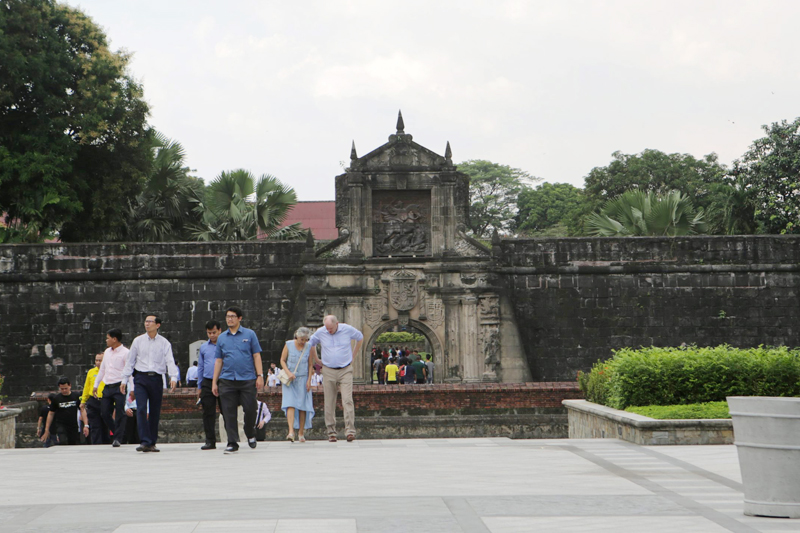
The revitalized Fort Santiago features more lush, green spaces and accessible walkways, making the historical site more visitor-friendly. STAR photos by Ernie Peñaredondo
MANILA, Philippines — The historic Fort Santiago, in the heart of the walled city of Intramuros, is one of the most visited tourist destinations in Manila because of its scenic ruins, rich culture, history and lessons from Filipino heroes who fought for the country’s liberation from colonizers.
A military fortress built by Spanish conquistador Miguel López de Legazpi and declared a Shrine of Freedom in 1950, the fort’s nomenclature was taken from Saint James – Santiago in Spanish – the patron saint of Spain.
According to the Intramuros Administration (IA) which maintains and oversees Fort Santiago, foreign and domestic travelers visit the historic place to learn its abundant stories.
Among the international guests who have visited Fort Santiago recently were leaders and their spouses of the Association of Southeast Asian Nations (ASEAN) during the summit in Manila last November and the 2017 Miss Universe beauty queens.
Intramuros administrator Guiller Asido says tourist arrivals at Fort Santiago have increased by 62.93 percent in 2017 compared to 2016. In fact, the IA’s target for the year was only 954,000 visitors while total tourist arrivals for 2017 hit 1,678,203.
In 2017, Fort Santiago generated an income of P33.3 million, which is higher than its total income in 2016 by some P2.5 million.
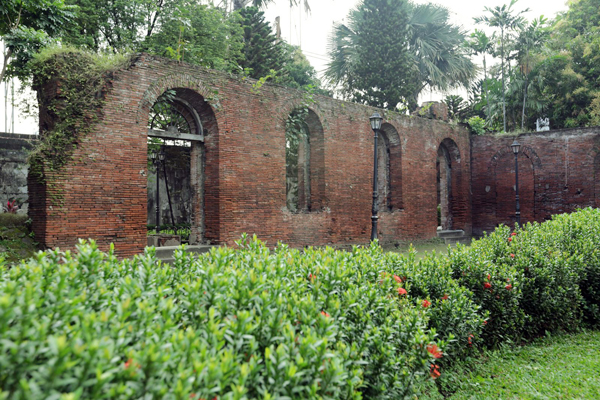
With the increasing number of tourist arrivals, the Tourism Infrastructure Enterprise Zone Authority (TIEZA) has budgeted around P10 million for repairs of Fort Santiago to revitalize the fort while maintaining its original relics.
Asido was appointed administrator of the IA a year ago, and during his tenure, he plans to revise the traffic plan in Intramuros and address the issues on informal settlers as part of redeveloping the Walled City.
The renovation and revitalization projects that have been launched or are currently being undertaken by the IA include:
Plaza Mayor. The Plaza Mayor, located outside Fort Santiago’s gate, served as the parade ground of the Spanish and the Americans during the early 1950’s.
From a parade ground full of palm logs, shrubs and bamboo, the Plaza Mayor has been re-landscaped and paved with granite tiles, turning it into a Mediterranean garden or a European-inspired park, providing a more walkable space for visitors.
“By re-landscaping the plaza, it gives you a better visual of the Fort Santiago. We also wanted to increase the green spaces,” Asido says.
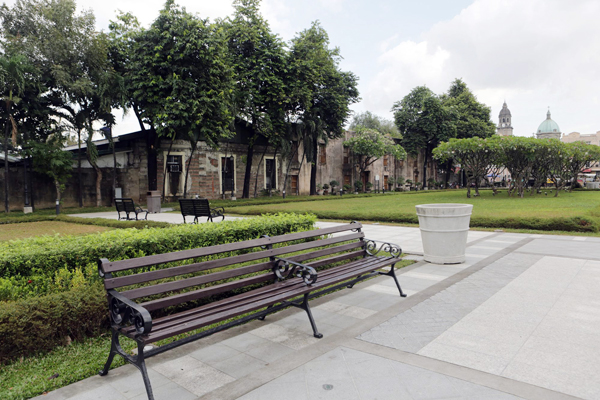
Mural of Raja Sulayman. Along with the re-landscaping of the Plaza Mayor, the walls on the left side of the plaza which were once covered by thick moss were cleared for Raja Sulayman’s mural.
Raja Sulayman was a Filipino-Muslim leader who owned the land where Fort Santiago was built in the 1570’s after he was defeated by the Spanish colonizers.
The mural was designed by a group of Manila-based artists and was executed by more than 20 students from the Mapua University. It took them more than two weeks to finish the mural.
Rajah Sulayman Theater. The Rajah Sulayman Theater is located in the ruins of a former Spanish military barracks. It was closed as a venue for gatherings and events for several decades because of its run-down condition.
The Rajah Sulayman Theater has since gotten a facelift and is now open to public. Last year, the Philippine Educational Theater Association (PETA) performed at the venue during their anniversary in November.
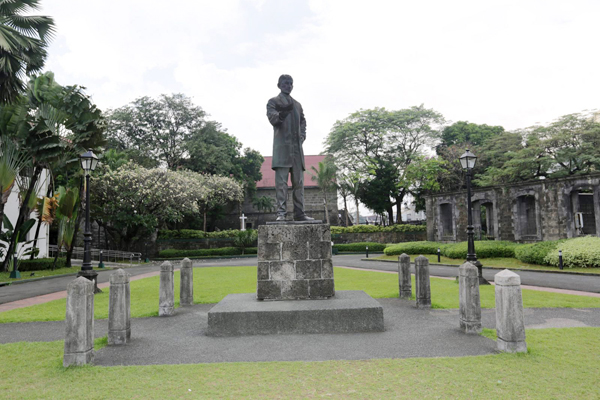
A statue of the national hero fronts the Rizal Shrine.
The Manila Biennale, a large art exhibition and music festival ending this weekend, was held at the Rajah Sulayman Theater and other venues in Intramuros, highlighting the significance of the Walled City in Philippine history.
It also pays tribute to Manila’s role in World War II through displays of public artworks curated by Ringo Bunoan, Alice Sarmiento, Con Cabrera and Cocoy Lumbao and some live performances at the Cultural Center of the Philippines.
“We want to ensure as well that the Fort Santiago can be seen and appreciated not only because of the historical and cultural aspect, but also as the hub for performances, arts, for better appreciation of the site,” Asido says.
He adds that the Rajah Sulayman Theater can also be used for workshops, photoshoots for debuts and weddings, among others.
American barracks. The American barracks served as the military offices of the American forces during the American occupation in 1898 as well as World War II when they fought against the Japanese colonizers. Bullet holes can still be seen within the barracks.
Asido explained that they are re-landscaping the barracks to make it more suitable as a tourist hub. Eventually, shops and cafés may also open there.
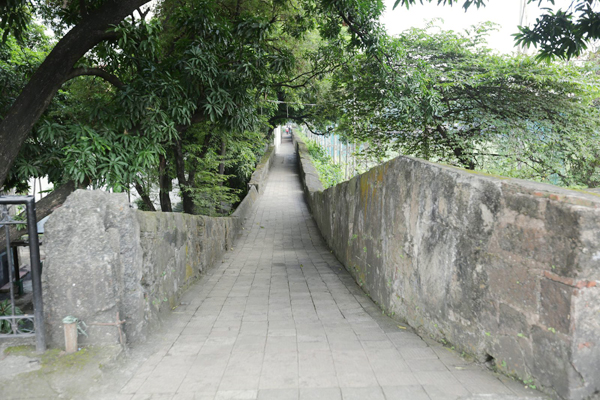
Walkways around the fort have been made safer and more walkable.
The re-landscaping though will leave the relics at the American barracks untouched as only lighting will be put in to make the area more walkable.
Soledad Promenade. Governor General Simon de Anda escaped from British invaders during the British occupation in 1762 through the Soledad Promenade, the walkway facing the Pasig River.
Before it was opened to the public in April last year, the Soledad Promenade was surrounded by trees and grass – and filled with garbage.
Aside from cleaning the place up, light features have been put in place so visitors can get a glimpse of the historic place where De Anda escaped. Repairs will cover the area from the promenade up to Maestranza, near the Bureau of Immigration.
Baluarte de Santa Barbara. During the Spanish period, the Baluarte de Santa Barbara served as the soldier’s artillery storage area. Today, it will become a Lego Learning Center.
“With the additional destination area, there will be a better appreciation of Fort Santiago and a better appreciation of the heritage as well,” Asido said.
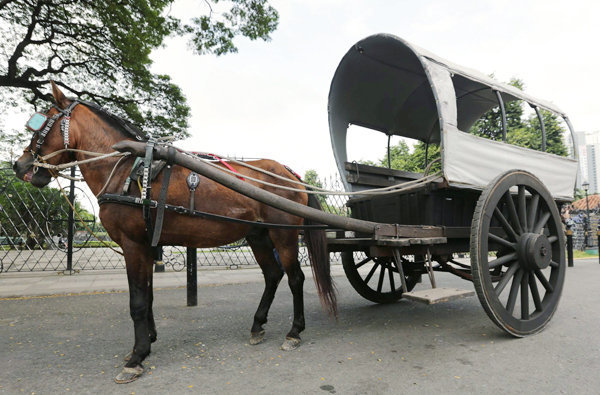
To kick off the Lego center opening, a Lego contest dubbed “iMake History Fortress Architecture Scale Model Competition” was held, participated in by 12 teams of architecture and engineering students from different colleges and universities in the Philippines.
The Lego contest focused on reconstructing the old buildings in Intramuros using special Lego architectural bricks and aims to deepen students’ appreciation of the diverse and rich history of Intramuros.
Rizal Shrine. Aside from additional lighting and other minor changes, a Hungarian translation of Dr. Jose Rizal’s “Mi Ultimo Adios” was added to the list of translations of Rizal’s masterpiece displayed in the shrine.
The iconic golden footprints of Rizal leading from his detention cell to the main gate of Fort Santiago – his last steps before his execution at Bagumbayan (now Luneta Park) in 1896 – will also be restored.
Plaza de Armas. Plaza de Armas, the circular ground inside Fort Santiago’s main gate which was part of the military fortress during the Spanish and American periods, will be redesigned to make it more walkable for persons with special needs.
Distelleria Limtuaco. Last Jan. 29, the Destileria Limtuaco Museum along San Juan de Letran was opened.
Destileria Limtuaco is the country’s oldest brewery, which started in the 1850’s by brewer Lim Tua Co.
The museum features the distillery’s evolution through its bottles, barrels and machinery, and portraits and memorabilia of the family who still manage the brewery to this day.
Museo de Intramuros. The Museo de Intramuros will feature the ecclesiastical art collection of Intramuros and other pieces from the extensive collection of the IA.
The museum, located at the reconstructed San Ignacio Church and Convent along Arsobispo street, will feature collections of Juan Luna and Damian dela Rosa as well as religious statues and paintings from different churches during the 16th to 18th centuries.
It will also showcase some of the country’s material culture and heritage during the Spanish colonial period to the pre-war era.
“This where it all started,” Asido says. “If you want to know more about Philippine history, the legacy of our Filipino heroes and our culture, come and visit Fort Santiago.”
He adds, “We are creating a new narrative for Intramuros as an urban heritage district – inclusive, dynamic, resilient and creative, but with due regard to the historic and heritage value of the place. In doing this, we are setting the identity of Intramuros.”
* * *
Fort Santiago is open from 9 a.m. to 9 p.m. daily, with entrance fee of P75 for adults and P50 for students and persons with special needs.
- Latest
- Trending














